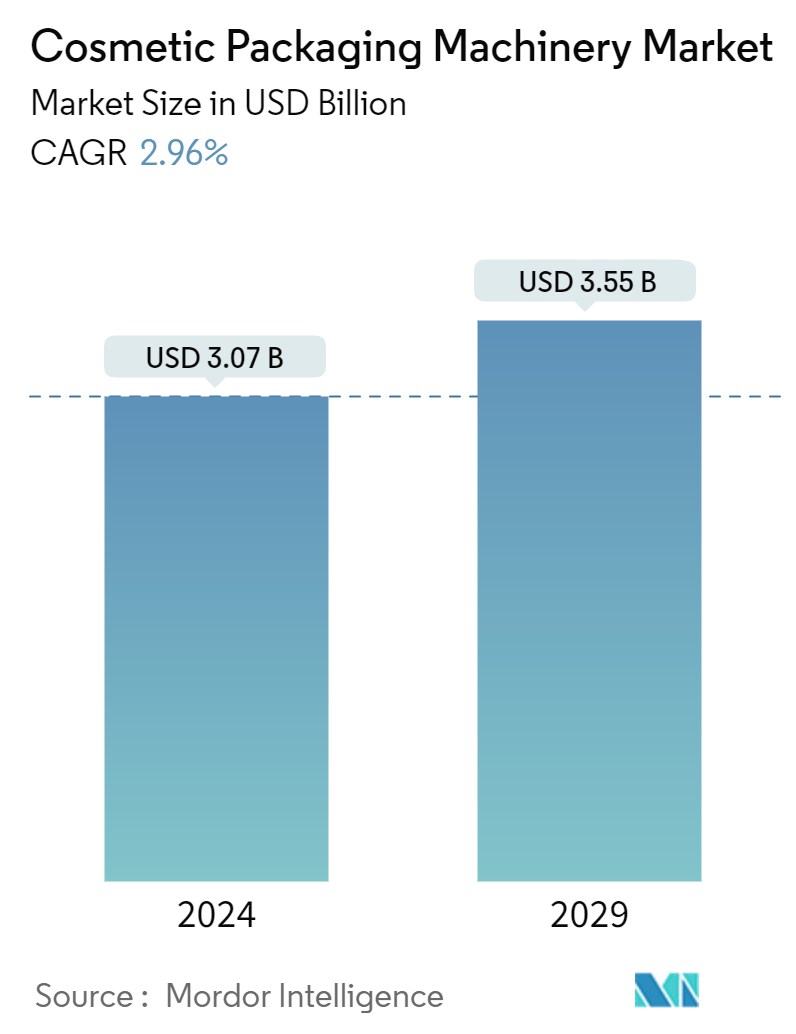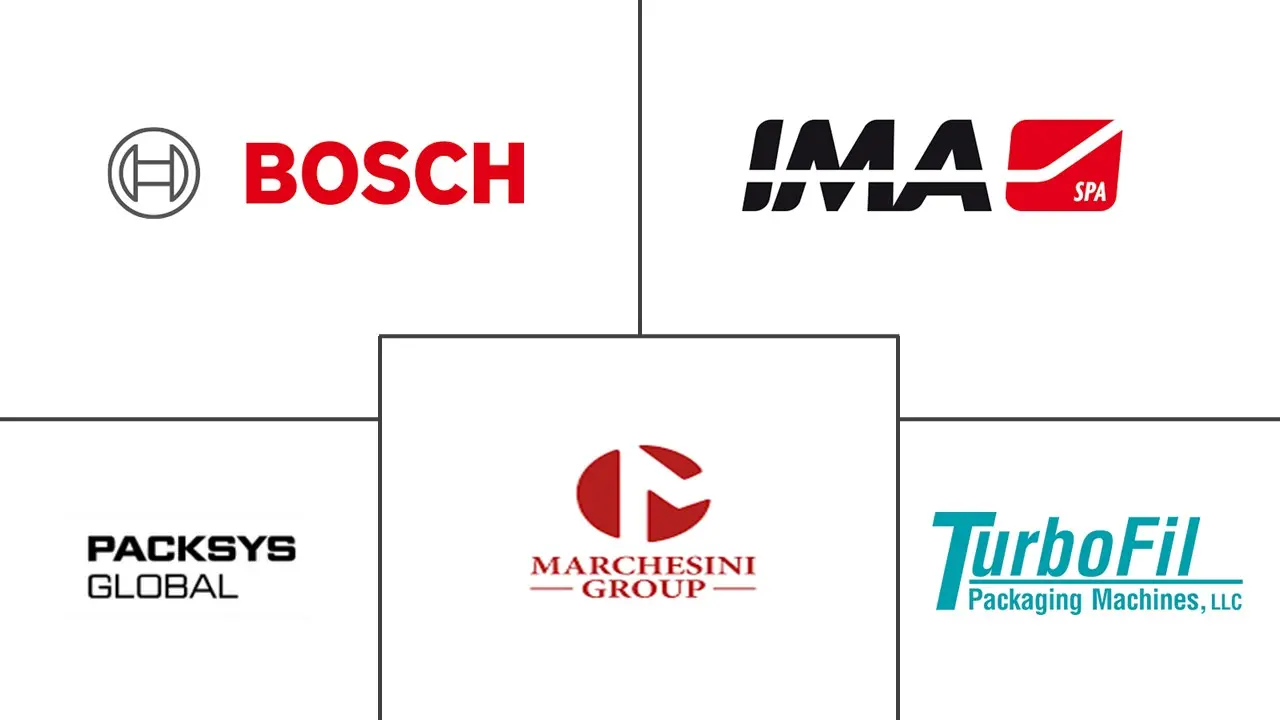Market Size of Cosmetic Packaging Machinery Industry

| Study Period | 2019 - 2029 |
| Market Size (2024) | USD 3.07 Billion |
| Market Size (2029) | USD 3.55 Billion |
| CAGR (2024 - 2029) | 2.96 % |
| Fastest Growing Market | Asia Pacific |
| Largest Market | North America |
| Market Concentration | High |
Major Players
*Disclaimer: Major Players sorted in no particular order |
Cosmetic Packaging Machinery Market Analysis
The Cosmetic Packaging Machinery Market size is estimated at USD 3.07 billion in 2024, and is expected to reach USD 3.55 billion by 2029, growing at a CAGR of 2.96% during the forecast period (2024-2029).
Cosmetics packaging machines are specialized equipment for various cosmetic items, from creams and lotions to perfumes and lipsticks. They play a pivotal role in packaging and handling tasks like filling, sealing, labeling, and capping. This guarantees that cosmetic products are packaged efficiently and maintain high hygiene standards. The rising consumer consciousness regarding personal grooming and beauty products fuels the demand for efficient packaging solutions. According to L’Oréal, the global cosmetics market grew 8% in 2023 compared to the previous year.
- Factors such as the growing millennial population, increasing urbanization, and rising incomes of consumers are the major contributors to the growth of the cosmetic industry. Urbanization has created several opportunities for the players in the market by raising disposable income and creating awareness about the availability of various cosmetics, thereby significantly spurring the demand for cosmetic products and packaging. According to the Population Reference Bureau, global urbanization stood at 57% in 2023. North America, Latin America, and the Caribbean led the charge, with over 80% of their populations living in urban centers.
- High-income consumers are highly inclined to spend on luxury and organic cosmetics. Gen Z consumers are increasingly swayed by cosmetic brand marketing efforts, leading to a surge in spending intentions. For instance, in the United Kingdom, consumer spending on personal care products surged from GBP 7,992 million (USD 9940.2 million) in 2022 to GBP 8,976 million (USD 11,164.1 million) in Q2 2023. This uptick in European consumer spending underscores the region's rising demand for diverse packaging solutions.
- Innovations in packaging technology, such as automation and the integration of IoT, enhance the efficiency and capabilities of packaging machines. For instance, in May 2054, L'Oréal introduced a range of innovations under the banner 'Beauty for Each, Powered by Beauty Tech.' These innovations encompass advanced skin and hair diagnostics, a personal beauty assistant powered by GenAI, a GenAI Beauty Content Lab named CREAITECH to boost creativity, a groundbreaking hair dryer utilizing infrared light technology, a micro-resurfacing device enhancing skincare, and an advanced technology platform mimicking human skin for scientific research and product testing.
- Amid a rising emphasis on sustainability, cosmetics manufacturers increasingly seek natural and eco-friendly ingredients and emulsifiers. The shift toward 'green' beauty is not just a passing trend. Research highlights the toxicity of conventional cosmetics, propelling the rapid and sustainable growth of the demand for natural cosmetics. Consumers are becoming more aware of their choice's environmental and health impacts, driving demand for products that align with their values. This trend is expected to continue, with innovations in natural ingredients and sustainable practices further enhancing the appeal of green beauty products, thereby creating more opportunities in the market studied.
- Moreover, the cosmetics packaging machinery sector faces significant limitations in terms of high initial capital demands. This financial barrier can be incredibly daunting for small and medium-sized cosmetic manufacturers, hindering them from investing in advanced packaging equipment. Therefore, the industry sees limited new entrants, reducing competition and stifling innovation.
- Changes in environmental and safety regulations can require companies to upgrade their packaging machinery to meet new standards, leading to additional costs. This can be particularly challenging during times of economic stress. In addition, the conflict has affected the packaging ecosystem by disrupting supply chains and causing fluctuations in raw material prices.
Cosmetic Packaging Machinery Industry Segmentation
Cosmetics are products that range from lipstick, eye shadow, and other makeup to nail polish, facial creams, skin lotions, and shampoo. Even perfumes and toothpaste could be considered cosmetics. The products packaged in the cosmetic industry are wide and varied, and the packaging machines used to pack them are identified as cosmetic packaging machinery. The market defines the revenue generated from the sales of cosmetic packaging machinery across various regions that are packaged with multiple materials such as paper, glass, plastic, etc.
The cosmetic packaging machinery market is segmented by machine type (form/fill/seal machinery, labeling machinery, capping machinery, wrapping machinery, and other machine types) and geography (North America, Europe, Asia-Pacific, Latin America, Middle East & Africa). The impact of macroeconomic trends on the market is also covered under the scope of the study. The disturbance of the factors affecting the market's evolution in the near future, as well as drivers and constraints, has been covered in the study. The market sizes and forecasts are provided in terms of value (USD) for all the above segments.
| By Machine Type | |
| Form/Fill/Seal Machinery | |
| Labelling Machinery | |
| Capping Machinery | |
| Wrapping Machinery | |
| Other Machine Types |
| By Geography | |
| North America | |
| Europe | |
| Asia-Pacific | |
| Latin America | |
| Middle East and Africa |
Cosmetic Packaging Machinery Market Size Summary
The cosmetic packaging machinery market is experiencing significant growth, driven by the shift from traditional to next-generation automated packaging solutions. These advanced machines, which are designed to be more efficient and environmentally friendly, are increasingly in demand due to the rising popularity of customized beauty products. Factors such as the growing millennial demographic, urbanization, and increased consumer incomes are contributing to the expanding consumer base for cosmetics, thereby boosting the demand for innovative packaging solutions. The market is also seeing a trend towards the use of recyclable materials like PET and polyethylene, which cater to environmentally conscious consumers. However, the high initial capital required for upgrading packaging lines and stringent government regulations pose challenges to market expansion.
The market landscape is characterized by fragmentation, with numerous key players engaging in strategic activities such as acquisitions, collaborations, and product innovations to enhance their market presence. Companies like Bosch Packaging Technology, IMA Industria Macchine Automatiche, and Marchesini Group are at the forefront, offering advanced packaging solutions. The United States remains a significant market, known for its innovative cosmetic products and packaging technologies. The adoption of automation and smart manufacturing processes is on the rise, improving efficiency and production capabilities. Additionally, initiatives focusing on eco-friendly packaging and the integration of artificial intelligence are expected to shape the future of the industry, further driving market growth.
Cosmetic Packaging Machinery Market Size - Table of Contents
-
1. MARKET INSIGHTS
-
1.1 Market Overview
-
1.2 Industry Value Chain Analysis
-
1.3 Industry Attractiveness - Porter Five Forces Analysis
-
1.3.1 Bargaining Power of Suppliers
-
1.3.2 Bargaining Power of Consumers
-
1.3.3 Threat of New Entrants
-
1.3.4 Intensity of Competitive Rivalry
-
1.3.5 Threat of Substitutes
-
-
1.4 Impact of Key Macroeconomic Trends on the Market
-
1.5 Market Drivers
-
1.5.1 Growing Demand for Personal Care Products
-
1.5.2 Increasing Industrial Automation
-
-
1.6 Market Challenges
-
1.6.1 High Intitial Capital Requirement
-
-
-
2. MARKET SEGMENTATION
-
2.1 By Machine Type
-
2.1.1 Form/Fill/Seal Machinery
-
2.1.2 Labelling Machinery
-
2.1.3 Capping Machinery
-
2.1.4 Wrapping Machinery
-
2.1.5 Other Machine Types
-
-
2.2 By Geography
-
2.2.1 North America
-
2.2.2 Europe
-
2.2.3 Asia-Pacific
-
2.2.4 Latin America
-
2.2.5 Middle East and Africa
-
-
Cosmetic Packaging Machinery Market Size FAQs
How big is the Cosmetic Packaging Machinery Market?
The Cosmetic Packaging Machinery Market size is expected to reach USD 3.07 billion in 2024 and grow at a CAGR of 2.96% to reach USD 3.55 billion by 2029.
What is the current Cosmetic Packaging Machinery Market size?
In 2024, the Cosmetic Packaging Machinery Market size is expected to reach USD 3.07 billion.

